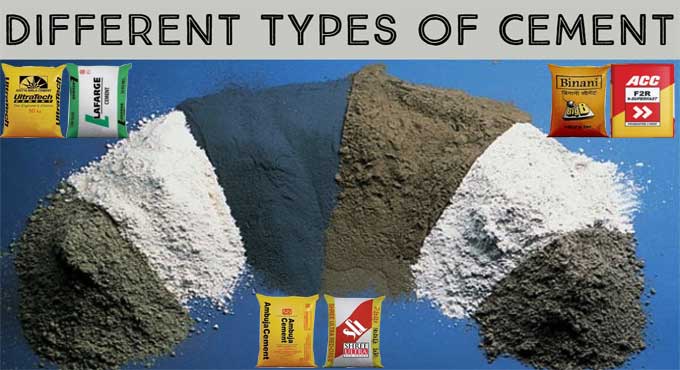NEWS | SOFTWARE | SHEET
Types of Cement Used in Construction and Civil Engineering
Among other things, cement is used for constructing houses, roadways, and brick-and-motor structures. Unless you believe that this material fits everyone, you are completely incorrect. The various varieties of cement on the market for various building applications deserve some attention.
There are a number of cement varieties that differ in terms of their quality, technology, composition, and intended use for construction sites. Other kinds are used for ornamentation, while others are used for normal masonry construction.
Due to its adhesive and cohesion properties, cement serves as a binding component for concrete to give high bond strength. To give the construction the necessary stiffness, cement is blended with filler materials such as sand and pebbles.
Adding enough water to cement, fine aggregates, and coarse aggregates produce concrete. Ordinary Portland cement, Portland pozzolana cement, rapid hardening cement, and others, are all types of cement available on the market.
Types of Cement and its application available in the market: Here are the few types of cement available in the market:-
Ordinary Portland Cement: The manufacturing process of OPC involves the pulverization of limestone, calcium sulfate, and calcium silicate clinkers at high temperatures. Bogue's compounds are the key ingredients in this type of cement, which lend strength to growth and hardening. As cement is made from calcium sulfate and gypsum, it is pulverized into fine powder by mixing it with cement clinker.
Its Uses:-
- Beams, columns, slabs, footings, and other structural components.
- Cladding,
- Tanks,
- Sanitary sewers,
- Enormous constructions and mass building.
Portland Pozzolana Cement: Fly ash is a byproduct of thermal power facilities and is a constituent of this cement, as well as ordinary Portland concrete clinkers. It is not just about reducing air pollution when fly ash is added to cement, but it is also good for enhancing its strength.
During the early stages of the game, flyash slows down the rate at which you build strength. Although the cement becomes stronger as it progresses, the strength doesn't last forever. Cement's strength is derived from the calcium silicate gel formed by the combination of calcium hydroxide and fly ash in hydration products. Three months can be kept in this kind of cement if it is kept in a cold, dry area.
Its Uses:-
- Activities are normally associated with construction.
- Construction of enormous scale.
- A structure designed to retain water.
- This kind of cement can be used in a structure based on water and a hydraulic system.
Rapid Hardening Cement: Rapid hardening cement is the ideal solution for situations that demand speedier building in a shorter time frame. As the name suggests, it sets in just 30 seconds initially and 600 minutes as the final setting time. The secret to this strength lies in its formula which contains a higher percentage of Tri-Calcium Silicate than a regular Portland Cement.
Its Uses:-
- Can be utilized for road maintenance, pavements, and pre-fabricated structures.
- It is not recommended for mass building sites because of the significant danger of cracking.
- It is hydraulic cement of exceptional strength, for which it can be used for any precast construction purposes.
Extra Rapid Hardening Cement:Fast Setting Cement has been upgraded to Extra Fast Setting Cement. In addition to the RHC composition, a weight percentage of not less than 2% calcium chloride is added to the cement. This accelerates the hydration process.
Some fast-setting types of cement may reach 15 MPa and 25 MPa in not less than a day, respectively. To avoid hardening, concrete must be poured within 20 minutes of being mixed with water. This sort of cement may be kept for one month before losing its quality and becoming useless.
Its Uses:-
- Can be applicable, when concreting in cold temperatures.
- Construction using precast concrete.
To get more clear ideas, go through the following exclusive construction video tutorial.
Lecturer: Amazing Civil Engineering Study
Low Heat Cement: During the setting process, low-temperature cement creates less heat for hydration. Excessive hydration heat might cause premature shrinkage cracks. Heat accumulation can be reduced by lowering heat-generating Bogue chemicals.
To attain appropriate strength with minimum heat generation, tricalcium silicate and tricalcium aluminate are lowered while dicalcium silicate is raised. Because of the delayed hydration process, the initial strength growth is reduced, but the needed strength is acquired later.
Its Uses:-
- Dams, enormous retaining walls, bridge abutments, and so on can be utilized using this kind of cement.
- Concreting in hot temperatures.
Costly Cement: Ordinary Portland cement clinker, swelling agents, and stabilizing chemicals make up expensive cement. As cement hardens, it shrinks, which can cause non-structural cracking in the building. Shrinkage can be avoided by applying blowing agents like sulfoaluminate clinker. To prevent overstretching, blowing agents must always be used with stabilizing agents like calcium chloride or pozzolan.
Expensive cement comes in two varieties: shrinkage compensating expanding cement and self-tightening expanding cement. The presence of sulfates increases the risk of sulfate attack.
Its Uses:-
- Mass construction.
- Roof slab.
- Canal and tunnel lining.
- Concrete parchment.
- Repairing works of concrete structures.
White Colored Cement: The presence of iron oxide gives the cement its grey color, white cement may be made by lowering the quantity of iron oxide in the cement to less than 1%. White cement is manufactured from high-purity limestone and china clay, both of which contain little iron. It costs more than regular cement. White cement has a higher fineness than regular cement.
Its Uses:-
- Repairing tiles and marbles.
- Finishing the floor.
- Works of ornamentation.
- Plastering using stucco.
- Industries using precast concrete.
- Pavers because of their great reflectivity.


